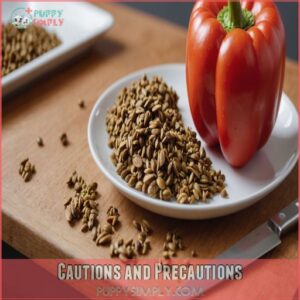This site is supported by our readers. We may earn a commission, at no cost to you, if you purchase through links.

Packed with vitamins like A and C, bell peppers can boost your pup’s immune system and keep their coat shiny.
Just make sure you remove the seeds and core—think of it as taking out the trash before the party.
Also, aim for moderation; too much might upset their stomach.
These colorful veggies are great as an occasional treat but skip the seasoning—Fido won’t miss the salt!
Curious about which color is best or how to prepare them? We’ve got some tips to spice up your dog’s diet without the spice!
Table Of Contents
- Key Takeaways
- Nutritional Value of Bell Peppers
- Can Dogs Eat Bell Peppers Safely
- Health Benefits for Dogs
- Colors of Bell Peppers
- Serving Size and Preparation
- Recommended Intake for Dogs
- Cautions and Precautions
- Ensuring Safe Consumption
- Frequently Asked Questions (FAQs)
- Are bell peppers bad for dogs?
- Is bell pepper good for dogs?
- Is Pepper Bad for dog?
- Can dogs feel heat from peppers?
- Can dogs eat raw bell peppers?
- What peppers are toxic to dogs?
- Which color bell pepper is the healthiest?
- Can dogs eat jalapeños?
- Can puppies eat bell peppers?
- Are bell pepper stems safe for dogs?
- My dog ate a whole pepper; is that bad?
- Can I give my dog roasted bell peppers?
- What if my dog is allergic to peppers?
- Conclusion
Key Takeaways
- You can safely feed your dog bell peppers, which are rich in vitamins A, C, and antioxidants, similar to how Bok Choy for Dogs can be a nutrient-rich addition to their diet, but always remove the seeds and stems to avoid any digestive issues.
- Introduce bell peppers gradually to your dog’s diet, monitoring for any allergic reactions or stomach upset, and treat them as occasional snacks, not meal replacements.
- Avoid giving your dog spicy peppers like jalapeños, as they contain capsaicin, which can cause discomfort and upset their stomach.
- Consult your veterinarian before adding bell peppers to your dog’s diet, especially if your pet has any dietary restrictions or health conditions.
Nutritional Value of Bell Peppers
When you’re thinking about giving your dog a tasty treat, bell peppers pack a punch with vitamins A, C, E, and B6.
These colorful veggies support your dog’s immune system, coat, and eyes.
They also add a crunchy surprise to their diet.
Vitamins and Antioxidants
Think of bell peppers as nature’s multivitamin for your dog!
Packed with Vitamin C and antioxidants, these colorful veggies help keep your pup vibrant and healthy.
As a nutritious snack, bell peppers also provide vitamins A, E, B6, and K, as well as beta-carotene and fiber, as seen in the benefits of bell peppers.
Bell peppers are bursting with nutrients that fend off free radicals, just like a knight protecting a castle.
This antioxidant boost can improve overall dog health, making sure your furry friend stays playful and strong.
Remember, in moderation, they’re a crunchy snack packed with antioxidant benefits.
Immune System Support
Bell pepper benefits for your dog’s immune system are as fresh as they come!
Packed with vitamin C and antioxidants, these colorful veggies are natural immune booster foods.
As a nutritious addition to their meals, rice and beans can also be a great option, with types of rice for dogs like white, brown, and basmati rice providing essential nutrients. Consider them part of a healthy dog diet.
They help fend off sickness by reinforcing your pup’s natural defenses.
Think of them as a tiny veggie army, ready to protect!
Offering these as natural supplements keeps your furry friend vibrant and healthy.
Skin, Coat, and Eye Health
Though small, bell peppers pack a punch in boosting your dog’s skin, coat, and eye health. They’re like a mini makeover in a crunchy bite!
- Vitamin A: Promotes healthy eyes and vision.
- Vitamin E: Enhances skin health, giving shine to the coat.
- Beta-carotene: Converts to Vitamin A, boosting overall eye care.
- Antioxidants: Fight off harmful free radicals, supporting a strong immune system.
Can Dogs Eat Bell Peppers Safely
A common question among dog owners is whether bell peppers are safe for their furry friends.
The good news is, they are!
Bell peppers are rich in vitamins C and A, beta-carotene, and fiber, making them a nutritious snack, as seen in the nutritional benefits of bell peppers.
Always remove the seeds and stems to avoid tummy troubles.
Cut them into small, bite-sized pieces to prevent choking.
Introduce them gradually, watching for any allergic reactions.
Treats are treats, not meal replacements, so keep bell peppers as an occasional snack.
A little goes a long way!
Too many can cause an upset tummy.
So, enjoy these safe snacks in moderation.
Health Benefits for Dogs
By adding bell peppers to your dog’s diet, you’re not just getting colorful leftovers off your plate—you’re boosting their health, too.
Bell peppers are packed with vitamins A and C.
These crunchy treats can strengthen your furry friend’s immune system and improve their skin and coat health.
Vitamin Content
Craving vibrant health for your furry friend? Bell peppers are packed with essential vitamins.
Here’s what you need to know:
- Vitamin A benefits: Supports healthy vision and skin.
- Vitamin C benefits: Boosts the immune system, keeping those tails wagging.
- Vitamin B6 role: Important for brain function and red blood cell health.
These vitamins make bell peppers a colorful and healthy treat for dogs, adding a sprinkle of vitality to their diet.
Antioxidant Effects
Bell peppers pack a powerful punch in terms of fighting free radicals, those pesky little molecules that can cause damage in your dog’s body.
Antioxidant power makes these veggies like tiny superheroes working on the side of dog health.
They help shield cells from harm, keeping your furry friend feeling spry and playful.
So, offering these crunchy treats taps into a reliable ally in your dog’s wellness arsenal.
Immune System Boost
Even your dog’s immune system could use a little boost, right? Bell peppers for puppies are an immune-boosting treat packed with vitamin C, which strengthens their natural defenses.
To keep your pup’s immune system health in top shape, try these simple steps:
- Introduce bell peppers gradually,
- Monitor for reactions,
- Keep portions small,
- Consult your vet for specific advice.
Treats like cooked asparagus for digestive health benefits support overall health when prepared correctly. Treats like these support overall dog health benefits.
Colors of Bell Peppers
When deciding which bell peppers to feed your dog, remember that all colors—red, green, yellow, and orange—are safe and nutritious, with red peppers packing the most vitamins and antioxidants.
Don’t worry if your pup seems to prefer one color over another; a dash of variety might just tickle their taste buds.
Red Bell Peppers
Red bell peppers pack a punch as a nutritional powerhouse for your dog, with the highest vitamin C content among their colorful counterparts.
These vibrant veggies boost immune health and contain beta-carotene, which supports eye and skin health.
If you’re looking to safely incorporate red bell peppers into your dog’s diet, check out products specifically labeled as red bell pepper dog safe.
Just like a superhero in a salad, they bring a splash of color and vitamins to your dog’s diet.
Remember, moderation is key—treat them as an occasional snack.
Green, Yellow, and Orange Peppers
While red peppers often steal the show, don’t overlook green, yellow, and orange varieties!
These colors offer subtle differences in taste and texture.
Your dog might even have a favorite!
Here’s what to keep in mind:
- Green peppers are slightly more bitter.
- Yellow peppers have a sweeter taste.
- Orange peppers are a happy medium.
- Introduce each color gradually to see how your pup reacts.
Remember, moderation is key!
Vitamin and Antioxidant Content
Each color of bell pepper offers a unique blend of vitamins and antioxidants, bolstering your dog’s health.
Red peppers, often called the superstars, boast more vitamins A and C, compared to their green, yellow, and orange counterparts.
These vitamin-rich foods enhance immune support, making antioxidants superhero allies in your dog’s diet.
Use them confidently as dog diet supplements to boost their energy and happiness with safety in mind.
Serving Size and Preparation
When serving bell peppers to your dog, introduce them gradually, and always remove the seeds and stems to avoid indigestion.
You can serve them raw or lightly steamed.
If you’re looking to mix things up with fruits and veggies like apples or cantaloupe according to the ultimate guide to what chihuahuas can and cant eat safe options for Chihuahua diets, it’s always a good idea to consult your vet before adding new treats to your dog’s diet.
Introducing Bell Peppers
Introducing bell peppers to your dog’s diet can feel like adding a new spice to your pantry.
Start with small bell pepper treats, ensuring a safe introduction.
Observe your dog’s reaction in moderation to avoid any tummy troubles.
Remember: a little goes a long way in tapping into the nutritional value of these colorful veggies, keeping it safe and beneficial!
Removing Seeds and Stems
Removing seeds and stems from bell peppers helps avoid digestive issues and reduces choking hazards for your dog.
Use these best practices:
- Slice the pepper lengthwise to expose seeds.
- Scoop seeds with a spoon.
- Trim stems carefully.
- Inspect for any remaining seeds.
- Rinse thoroughly.
Following these seed removal techniques and stem removal methods keeps your pup safe and happy.
Steaming or Pureeing
When it comes to cooking methods, steaming vs. pureeing offers flexibility for your pup’s texture preferences.
Steaming keeps nutrients intact, making it a top choice for retaining vitamins.
Pureeing, on the other hand, can aid digestion—think of it as a smoothie for your dog!
By choosing wisely, you offer digestive benefits while keeping their meals tasty and nutritious.
Consulting a Veterinarian
Guidance from a veterinarian is like having a co-pilot for your dog’s diet. Before introducing bell peppers, especially if your pup has dietary restrictions or allergies, get feeding advice from your vet, and also consider implementing a regular pet care routine to monitor their health and adjust their diet accordingly.
- Assess specific needs
- Consider health conditions
- Get personalized feeding advice
- Avoid potential allergies
- Ensure safe, balanced diet
Recommended Intake for Dogs
So, how much bell pepper is right for your furry friend?
The amount depends on your dog’s size, with smaller dogs needing just a few small pieces while larger dogs can handle a bit more, but always remember moderation to avoid an upset tummy!
Extra-Small to Extra-Large Dogs
Wondering how much bell pepper your dog can munch on based on size?
If you’re unsure what size kibble is best for your small breed dog to prevent choking hazards, consider consulting the recommendations on small breed dog food.
Here’s a quick guide: if you’ve got an extra-small pup, a tiny slice will do. Small breeds can handle less than a quarter of a pepper. Medium to large dogs can enjoy up to half, while extra-large dogs can have a bit more.
Remember, treats like these are extras, not their main meal!
Preventing Overfeeding
Balancing bell pepper treats within your dog’s diet is like keeping your favorite chocolates in moderation.
For different dogs’ weight, use portion control, and consider referencing a dog bell pepper guide to make sure you’re giving your pup the right amount.
Extra-small dogs should nibble on just a couple of pieces.
Larger dogs can handle a bit more but keep treats under 10% of their daily intake.
You don’t want your pup turning into a veggie junkie, so mix in alternative treats occasionally!
Monitoring for Adverse Reactions
After introducing bell peppers to your dog’s diet, keep an eye out for any adverse reactions. Watch for symptoms like vomiting, diarrhea, or stomach upset, which could indicate sensitivity:
- Vomiting: An early warning sign
- Diarrhea: Check stool consistency
- Stomach Upset: Look for discomfort
- Skin Rashes: Observe for redness or bumps
- Itching: Scratching might increase
Remember, moderation is key.
Cautions and Precautions
When you’re introducing bell peppers to your dog’s diet, make sure you’re avoiding seasonings, salt, and toxic combinations like garlic and onions.
Keep an eye out for spicy varieties, which could lead to belly aches.
Be aware of any food allergies or sensitivities your furry friend might have.
Avoiding Seasonings and Salt
You’ve checked the recommended intake, but remember, adding seasonings and salt is a no-go when serving bell peppers to your dog.
Dogs don’t need that extra flavor kick from spices, and too much salt can lead to health issues.
Stick to salt-free treats and explore dog-safe spices like turmeric or parsley for more flair in their diet.
Toxic Combinations
When giving bell peppers to your dog, watch out for toxic combos.
Some ingredients can be silent troublemakers.
You can find dog bell pepper snacks online, but be cautious about what you’re feeding your furry friend.
Onions are toxic and can harm red blood cells.
Garlic can cause anemia.
Excess salt can lead to dehydration.
Chocolate is poisonous to dogs.
Grapes can cause kidney damage.
Spicy Varieties
Avoiding spicy peppers is important for your dog’s well-being.
Capsaicin, the compound making peppers hot, can cause mouth irritation and upset tummies.
Stick to sweet bell peppers; they’re packed with nutrients without the burn!
| Pepper Type | Capsaicin Content | Dog Reactions | Safe Alternative? |
|---|---|---|---|
| Jalapeño | High | Burning mouth, upset stomach | No |
| Habanero | Very High | Severe discomfort | No |
| Bell Pepper (Sweet) | Very Low | Usually none | Yes |
| Cayenne Pepper | High | Stomach upset, vomiting | No |
Remember, a little prevention goes a long way in keeping your furry friend happy and healthy.
Food Allergies and Sensitivities
Just like how some people sneeze at flowers, certain dogs might react to bell peppers.
Identifying triggers is key: watch for symptoms like itching or stomach upset.
If your furry friend reacts, consider allergy testing.
You can manage these reactions by finding safe alternatives.
Always consult your vet to make sure everything is okay while exploring new treats!
Ensuring Safe Consumption
When feeding bell peppers to your dog, ensuring safe consumption is key, so make sure to wash them thoroughly and remove any seeds and stems.
Consulting your veterinarian can prevent any "ruff" surprises and prioritize your dog’s health.
Cleaning and Preparation
Bell pepper safety starts with a good washing. Think of it as giving your peppers a spa day—this means rinsing away pesticides and dirt.
Chopping technique is important. Use a sharp knife for a precise cut, making them into dog-friendly pieces. Keep those seeds and stems out—they’re no party for a pup’s tummy.
Storage methods like refrigeration help keep them fresh.
For serving, try raw bell peppers or lightly steamed for easy digestion.
Prioritizing Your Dog’s Health
After giving bell peppers a thorough rinse, think of your dog’s health like a well-oiled machine. It needs just the right fuel—quality dog food, healthy treats, regular vet checkups, and a solid exercise routine.
Mixing in training tips helps your furry friend thrive.
Remember, balance is key. Treat bell peppers as an occasional snack, not the main dish. Your pup will appreciate the variety, and you’ll love seeing them wag with satisfaction.
Consulting a Veterinarian for Advice
Understanding dietary needs, especially with bell peppers, can feel like a puzzle.
Your veterinarian is the go-to expert for guiding you through your dog’s specific allergies, health conditions, and any medication interactions. They’ll help offer advice based on your dog’s age and unique needs.
- Schedule regular check-ups: Regular visits help make sure all dietary changes suit your dog’s health.
- Discuss allergies: Share any known allergies for specific advice.
- Ask about medications: Medication interactions matter.
Frequently Asked Questions (FAQs)
Are bell peppers bad for dogs?
No, bell peppers aren’t bad for dogs.
They’re actually quite nutritious, packed with vitamins and fiber.
Just introduce them slowly, remove seeds and stems, and serve in moderation.
Keep spicy peppers away to avoid upset tummies.
Is bell pepper good for dogs?
Imagine bell peppers as colorful shields protecting your dog’s health.
They’re rich in vitamins A, C, and E, boosting skin and immune health.
Just be sure to serve them in moderation, and your pup will benefit!
Is Pepper Bad for dog?
Pepper isn’t inherently bad for dogs.
Bell peppers can be a nutritious treat in moderation, offering vitamins and fiber.
Avoid spicy peppers like jalapeños, as they can cause stomach upset and burning sensations.
Can dogs feel heat from peppers?
Dogs sure can feel the heat from spicy peppers!
While bell peppers are fine, those fiery varieties like jalapeños can torch Fido’s tongue.
Their capsaicin content causes discomfort, so keep those spicy treats off the menu!
Can dogs eat raw bell peppers?
Yes, dogs can safely eat raw bell peppers. While introducing new vegetables, it’s essential to follow guidelines like those for safe squash feeding.
They’re packed with vitamins and fiber, supporting your pup’s health.
Just chop them into small pieces, remove seeds and stems, and introduce them gradually to avoid tummy troubles.
What peppers are toxic to dogs?
Spicy peppers like jalapeños, chili peppers, and habaneros are toxic to dogs because they contain capsaicin, which can irritate a dog’s stomach and cause discomfort.
Stick to mild peppers as treats for your furry friend.
Which color bell pepper is the healthiest?
Want the most nutritious bell pepper for your pup? Red bell peppers pack the biggest vitamin punch! They’re loaded with vitamins A, C, and more, boosting your dog’s health.
Can dogs eat jalapeños?
It’s best to skip feeding jalapeños to your dog.
They can cause stomach upset and mouth irritation.
Stick to safer treats like bell peppers, which pack nutrients without the spicy kick that might discomfort your furry friend.
Can puppies eat bell peppers?
Puppies can munch on bell peppers as a safe, nutritious treat packed with vitamins, boosting eye and immune health.
Serve them in small, bite-sized bits without seeds or stems to make sure they digest easily and stay safe.
Are bell pepper stems safe for dogs?
Bell pepper stems aren’t safe for dogs.
They can be tough to digest and might cause blockages or indigestion.
Always remove the stems before serving bell peppers to your dog to keep their meals safe and enjoyable.
My dog ate a whole pepper; is that bad?
If your dog gulped down a whole bell pepper, don’t fret too much.
It’s likely just a stomach twister.
Monitor for vomiting or diarrhea.
Keep water handy, and trust your instincts with vet checks if needed.
Can I give my dog roasted bell peppers?
Sure, you can give your dog roasted bell peppers, but keep them plain.
Avoid adding seasoning, oils, or spices that might upset your dog’s stomach.
Roasting can enhance flavor, but moderation is key to avoid digestive issues.
What if my dog is allergic to peppers?
Imagine your fridge as a menu: for dogs allergic to peppers, it’s time to scratch that item off.
Look out for itching, swelling, or stomach issues, and consult your vet for allergy-friendly snack alternatives.
Conclusion
Remember, 70% of dog owners give their pets table scraps, so you’re not alone in wondering about bell peppers!
So, can dogs eat bell peppers? Yes, but in moderation.
Small amounts of bell peppers offer vitamins and antioxidants.
Always remove seeds and stems.
Introduce them gradually to check for any tummy troubles.
If you’re unsure, chat with your vet. They can provide specific advice for your furry friend and help you determine the best way to incorporate bell peppers into their diet safely.



















